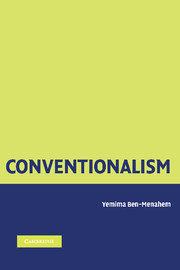Book contents
- Frontmatter
- Contents
- Preface
- 1 Overview: The Varieties of Conventionalism
- 2 Origins: Poincaré and Duhem on Convention
- 3 Relativity: From “Experience and Geometry” to “Geometry and Experience”
- 4 Implicit Definition
- 5 “Unlimited Possibilities”: Carnap on Convention
- 6 Metaphor and Argument: Quine on Convention
- 7 Wittgenstein: From Conventionalism to Iconoclasm
- References
- Index
3 - Relativity: From “Experience and Geometry” to “Geometry and Experience”
Published online by Cambridge University Press: 04 December 2009
- Frontmatter
- Contents
- Preface
- 1 Overview: The Varieties of Conventionalism
- 2 Origins: Poincaré and Duhem on Convention
- 3 Relativity: From “Experience and Geometry” to “Geometry and Experience”
- 4 Implicit Definition
- 5 “Unlimited Possibilities”: Carnap on Convention
- 6 Metaphor and Argument: Quine on Convention
- 7 Wittgenstein: From Conventionalism to Iconoclasm
- References
- Index
Summary
INTRODUCTION
No scientific theory has stimulated more intense debate over conventionalism than the theory of relativity. From early on, scientifically minded philosophers, such as Schlick, Reichenbach, and Carnap, and philosophically minded physicists, such as Eddington and Weyl, scrutinized the new theory, hoping to uncover within it an epistemological revolution parallel to that which had been wrought in physics. Conventionalism was central to many of these early explorations, and remained so throughout the twentieth century. The debate centered around the status of geometry. As we saw, Poincaré distinguished the conventionality of geometry from other manifestations of conventionality in science. In the case of geometry, he believed, there was a particularly powerful argument for the empirical equivalence of various physical geometries, and thus for the underdetermination of geometry by experience. On Poincaré's view, to prefer a particular (physical) geometry is basically to prefer a particular formulation of the facts of physics, facts independent of any such formulation, hence the conventionality of geometry. Subsequent discussion of conventionalism in the context of the theory of relativity continued to center on the conventionality of geometry, which is, accordingly, the subject of this chapter.
Whereas Poincaré had to invent fictitious worlds and fictitious theories to make his point, the advent of the theory of relativity, which breaks with both Newtonian mechanics and the theory of space and time in which it is embedded (Newtonian dynamics and Newtonian kinematics), obviated the need for fiction. Nevertheless, the theory that emerged was quite different from those Poincaré had envisioned.
- Type
- Chapter
- Information
- ConventionalismFrom Poincare to Quine, pp. 80 - 136Publisher: Cambridge University PressPrint publication year: 2006



